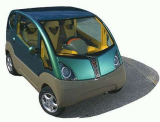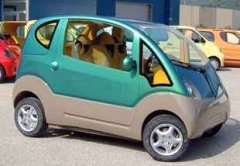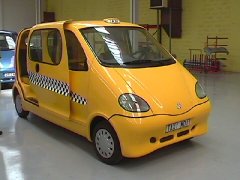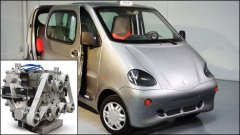The air powered car
9am, 15th January 2008 - Geek, Interesting, Hardware, Science There's an air powered car that has been causing some hype recently (which, I suppose, is considered "fuel" for this new car. Heh.) and, while it's not all that new, some people are cautiously (and not so cautiously) predicting that "2008 is the year of the air powered car". As a born skeptic, I felt the urge to play devil's advocate.
There's an air powered car that has been causing some hype recently (which, I suppose, is considered "fuel" for this new car. Heh.) and, while it's not all that new, some people are cautiously (and not so cautiously) predicting that "2008 is the year of the air powered car". As a born skeptic, I felt the urge to play devil's advocate.
My first thought was that the compressed air has to come from somewhere and that the process of compressing the air would require energy from more traditional sources. This technology isn't a new way of generating or extracting energy. Much like the talk of Hydrogen-powered cars, this is a new method of storing energy in cars that has been generated somewhere else. Most of these sorts of schemes don't help reduce pollution, they just offset it somewhere else. While this is good for people who live in cities, it's not any better for the planet as a whole.
 But there may be more to this plan than just offsetting the pollution. A compressed-air powered car has a few advantages over a Hydrogen powered car: Hydrogen has to be converted from it's pure state into a form with a lower energy content or higher entropy. This is usually achieved by combining it with Oxygen, which is readily found in the atmosphere. The process of combustion usually takes place inside a modified conventional engine or in a Hydrogen based fuel cell, however, both of these methods generate lots of wasted energy. The power extracted from the Hydrogen comes from the expansion of the gases as they combine. The sound and heat energy that is produced at the same time is dissipated into the environment and is wasted.
But there may be more to this plan than just offsetting the pollution. A compressed-air powered car has a few advantages over a Hydrogen powered car: Hydrogen has to be converted from it's pure state into a form with a lower energy content or higher entropy. This is usually achieved by combining it with Oxygen, which is readily found in the atmosphere. The process of combustion usually takes place inside a modified conventional engine or in a Hydrogen based fuel cell, however, both of these methods generate lots of wasted energy. The power extracted from the Hydrogen comes from the expansion of the gases as they combine. The sound and heat energy that is produced at the same time is dissipated into the environment and is wasted.
A compressed-air powered car, on the other hand, can extract the same gaseous expansion based energy as combustion based cars without the loss of the heat and sound-based energy. There has been some discussion (although the results I found were inconclusive) about whether the process of compressing the air was inefficient enough to offset the gains made with the more efficient power stations and in-car decompression process. The end result of reducing waste energy is that not only would the car cause less noise pollution, but the energy used to actually drive the car could be a greater percentage of the total energy available. Less waste is a good thing.
 There are, however, a few elements of the article that caused me some concern. The talk of the compressed air driving the pistons which in turn compress the air makes little sense. This is akin to using an electric motor to drive a generator which powers the electric motor. If it worked, it would violate the law of conservation of energy. I suspect (hope) that an over-enthusiastic reporter snuck this into the article rather than quoting directly from a scientist.
There are, however, a few elements of the article that caused me some concern. The talk of the compressed air driving the pistons which in turn compress the air makes little sense. This is akin to using an electric motor to drive a generator which powers the electric motor. If it worked, it would violate the law of conservation of energy. I suspect (hope) that an over-enthusiastic reporter snuck this into the article rather than quoting directly from a scientist.
The article also makes no mention of the range of the car apart from stating that there is a long-range version that would be fitted with a conventional engine. This suggests to me that this new car would suffer from the same drawbacks that electric cars suffer from: a range so small that the car is limited to the inner-city commute from home to work. After a quick Google and a visit to WikiPedia, it appears that other sites claim the range would be somewhere between 100Km - 200Km. That's great for those who only need that but I won't be swapping the long-range fuel tank in my Pajero for one of these until it comes closer to the same range. Earlier articles regarding the same technology suggest even lower ranges so with the technology getting better and better, hopefully the air car will achieve that goal eventually.
 Filling me with confidence again, the rest of the article shows that Negre (The motivation behind the idea) truly understands the problem of wasted energy. Firstly, the direct quote: "The lighter the vehicle, the less it consumes and the less its pollutes and the cheaper it is; it's simple," is very similar to one of the major principles behind low-energy building design. So often, when you design something inefficiently, you find that you need to waste more energy to fix problems with the design. Cars have added weight to deal with the wasted sound and heat energy which, in turn, requires more energy to carry around. Fridges emit all their heat at the back, which often gets trapped and heats the inside of the fridge back up. Fridges have to use extra energy just to remain below room temperature because the air around the fridge is above room temperature. The less wasted energy a car has, the less weight it needs to carry around to deal with the side-effects of the wasted energy. The less weight it has to carry around, the more you can do with the energy you have. In fact, the expansion of a compressed gas will actually draw in heat - the same way a fridge works - meaning the air can then be used for cooling the interior of the car. An air-conditioner and a radiator are two fewer pieces of machinery this car has to carry around thanks to it's more efficient design.
Filling me with confidence again, the rest of the article shows that Negre (The motivation behind the idea) truly understands the problem of wasted energy. Firstly, the direct quote: "The lighter the vehicle, the less it consumes and the less its pollutes and the cheaper it is; it's simple," is very similar to one of the major principles behind low-energy building design. So often, when you design something inefficiently, you find that you need to waste more energy to fix problems with the design. Cars have added weight to deal with the wasted sound and heat energy which, in turn, requires more energy to carry around. Fridges emit all their heat at the back, which often gets trapped and heats the inside of the fridge back up. Fridges have to use extra energy just to remain below room temperature because the air around the fridge is above room temperature. The less wasted energy a car has, the less weight it needs to carry around to deal with the side-effects of the wasted energy. The less weight it has to carry around, the more you can do with the energy you have. In fact, the expansion of a compressed gas will actually draw in heat - the same way a fridge works - meaning the air can then be used for cooling the interior of the car. An air-conditioner and a radiator are two fewer pieces of machinery this car has to carry around thanks to it's more efficient design.
Negre also has plans to use small factories in the same regions where the car is to be sold. This will probably cost slightly more - large scale factories have the advantage of being cheap on a per-car basis - but it will cost the environment less. He stated that the parts would not be shipped to the factory to be assembled but would rather be sourced locally - saving again on the environmental costs of shipping.
It's possible, with the advances in technology we have made, that the whole process may just even turn out cheaper in dollars than shipping the cars half-way around the world. Wasted energy and wasted effort are wasted dollars. If Negre understands this, and I think he does, then this venture should turn a profit for both his bank balance and the environment.
Related posts:
Burning water not so hot after allApocalypse tomorrow
Another part comes to life.
Dave's rebuttal of Macrovision's response to Steve Jobs' open letter about DRM in iTunes
Sudoku solving version alpha
Comments
Being a designer and an advocate for efficiency in design, I loved your quote about not throwing more energy at an energy wastage problem. That one is going on my desk at work.